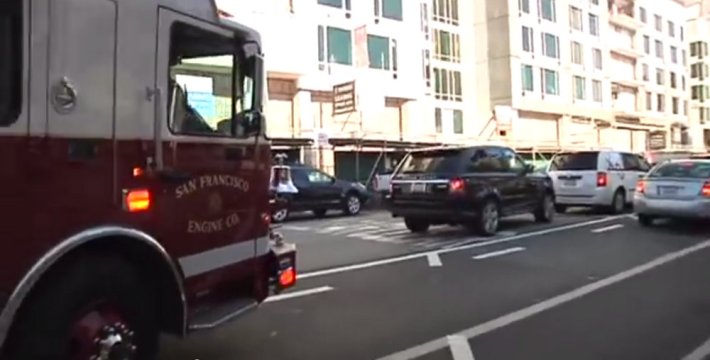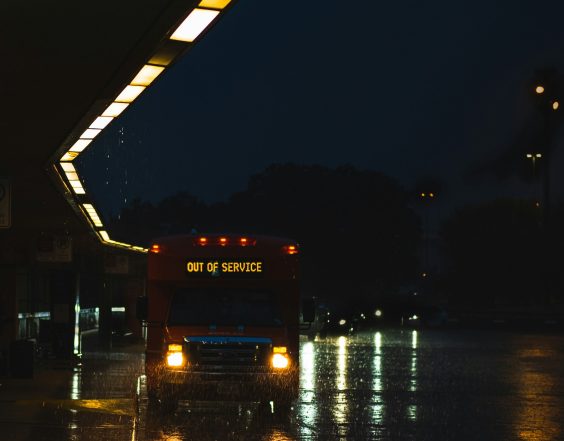
There's no telling where San Francisco Fire Chief Johanne Hayes-White got the patently false stats on pedestrian safety she cited to the SF Examiner yesterday. Hayes-White argued that the city shouldn't build proven pedestrian safety upgrades because most people hit by drivers while walking are to blame for their own injuries.
The Fire Department hasn't cited any data to back its misguided campaign against bulb-outs and bike lanes on the grounds that they cause delays for emergency vehicles. But what's clear to anyone on the streets is that firefighters and ambulances are constantly delayed by private autos, whether they're doubled-parked or sitting in congestion. By opposing proven safety upgrades on streets that see the very crashes they respond to, SFFD is making the city a more dangerous place to live.

As Walk SF Executive Director Nicole Schneider told the Examiner, it's "a shame."
"We’re all working on public safety here," she said. "What we need to be doing is building safer streets. These sort of improvements reduce deaths."
Hayes-White told the Examiner that "as many as 74 percent of pedestrian injuries result from jaywalking, other citable offenses or pedestrians being 'inattentive.'" But according to the SFMTA's 2010-2011 Collisions Report [PDF], out of the 844 non-fatal pedestrian crashes in 2011, police attributed 573 primarily to driver error. The five most commonly-cited factors were driver violations, the top being motorists' failure to yield the right-of-way in a crosswalk.
Despite the complete lack of data to support “distracted walking” as a significant cause of pedestrian deaths, Hayes-White and SFPD Chief Greg Suhr continue to blame the victims.
Meanwhile, as Supervisor Scott Wiener noted to the Examiner after a ride-along with SFFD responders, "Bulb-outs weren’t a problem. Double-parked cars are a huge problem for them." Another screamingly obvious observation is the fact that bulb-outs often replace curbside parking spaces. Yet SFFD would have the public believe that fire truck and ambulance drivers have an easier time navigating around parked cars than curbs.
It's hard not to cringe when watching recent media reports like the one from KTVU in October, showing fire truck drivers squeezing around stopped cars all while maintaining that the real problem is bulb-outs and bike lanes. The argument against unprotected bike lanes is especially perplexing, since they actually help provide a clear path for fire trucks (it's pretty easy for people on bikes to get out of the way).
This was illustrated in one of Stanley Roberts' recent People Behaving Badly segments (see below), filmed at Fire Station 1 on Folsom Street in SoMa. Roberts points out that drivers routinely block the "Keep Clear" zone intended to maintain a clear path of exit for fire trucks. What's also plainly visible (yet barely mentioned) in the segment is Folsom's new buffered bike lane, which now provides an emergency lane for fire trucks, except when car drivers violate it (as seen in the segment).
"During the commute, it can take firefighters as much as two minutes just to leave the station because of oblivious drivers," Roberts says in the piece.
SFFD has been reporting that its average response time has dropped by eight seconds over the past two years. (Oddly enough, SF County Transportation Authority staff reported this week that average driving speeds on arterial streets have actually increased by as much as 1 mph over the past two years, saying it might be due to less construction and a shift from driving to transit ridership.)
As we reported in 2011, San Francisco's roughly three pedestrian crashes per day cost the city big time -- an estimated $76 million per year, when accounting for medical treatment, emergency services, lost wages, and other impacts. As the Examiner reported yesterday, up to 75 percent of the Fire Department's calls are in response to emergency medical services. That includes traffic injuries, though it's not clear what share of those calls are responding to crashes.
City Hall and the SFMTA have rightly recognized the imperative to implement best practices proven to save lives. It's time for SFFD brass to re-think its hidebound, car-centric views and embrace efforts that complement the department's mission to keep people safe.





